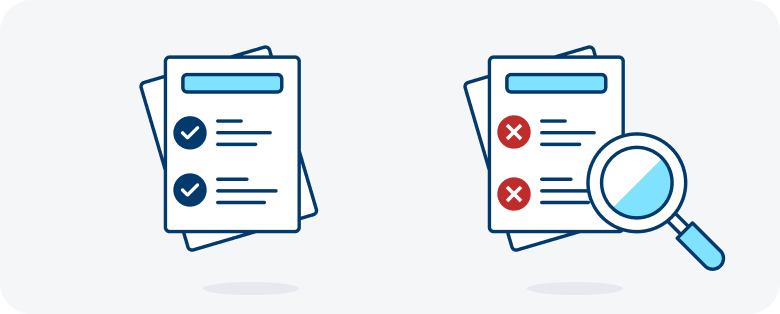If you’ve built up equity in a rental property and are low on cash reserves, it might feel impossible to start home improvements, expand your portfolio, or make other critical financial moves.
Thankfully, a cash-out refinance could be your golden ticket to tapping into that equity, converting it to cash, and addressing your needs.
But, while it may sound great on paper, is cash-out refinancing the right option for you?
Stay tuned to learn everything you need about this popular financial maneuver to access your property’s equity, including its pros and cons, different loan options, a step-by-step process to secure funding, and more.
A TurboTenant account unlocks comprehensive tenant screening, document storage, expense tracking, and everything else landlords need.
What is a rental property cash-out refinance?
When investment property owners want to liquidate the equity they’ve built up in a rental, they can use a cash-out refinance on their existing mortgage.
Essentially, a cash-out refinance occurs when property owners:
- Take out a new loan for a larger amount than the balance on their current loan
- Pay off their old loan with the funding from the new loan
- Pocket the extra money (cashed-out equity) to use as they wish
For example, let’s pretend a real estate investor wants to refinance a rental property valued at $500,000 with $300,000 left on its mortgage.
To do so, they take out a new $400,000 loan, pay off the remaining $300,000 on their old mortgage, pocket $100,000 in cash, and retain $100,000 in home equity. As a result, they’ve essentially converted half of their equity into cash, which they can now use however they see fit.
That sounds good, right? But before proceeding, investors must understand the pros and cons of cash-out refinancing.
Pros of Cash-Out Refinancing a Rental Property

There’s a lot to love about cash-out refinancing rental properties. Here are a few of its top potential benefits:
- Turn equity into cash: Cashing in equity gives property owners instant cash.
- Improve or repair your rental property: Refinances can fund expensive repairs and improvements to rental properties, raising their value.
- Debt consolidation: Funds from cash-out refinances often allow property owners to pay off higher-interest loans, like car notes and credit card debt.
- Buying power to expand your portfolio: Liquidating equity often gives real estate investors the cash they need for a down payment on a new property.
- Potential to lower your interest rate: If the timing is right, property owners could secure a new mortgage with a lower interest rate than the original.
Cons of Cash-Out Refinancing a Rental Property
Along with its potential benefits, cash-out refinancing comes with some downsides. Here are a few potential drawbacks to consider:
- Increased debt burden: Turning equity into cash in exchange for a new loan will restart a rental property investor’s mortgage and raise their debt burden.
- Closing costs (again): To execute a refinance, property owners will likely need to pay closing costs, typically between 2% and 5% of the new loan amount.
- Potential to raise your interest rate: If property owners refinance while interest rates are higher than with their first loan, they’ll forfeit their lower original rates.
- Longer loan repayment terms: Cash-out refinances restart the clock on a mortgage, lengthening the time a property owner must make payments.
Types of Cash-Out Refinancing for Rental Property

There are several routes property owners can take when considering a cash-out refinance. Here are a few of the most popular:
Conventional
Conventional refinancing is homeowners’ most common method to cash in on their properties’ equity.
These mortgages, which are regulated by government-sponsored enterprises Fannie Mae and Freddie Mac but aren’t insured or guaranteed by the government, typically require homeowners to have at least 20% equity in their property to qualify.
When seeking refinancing, lenders will allow property owners to borrow up to 80% of their rental’s current market value. If the lender approves that the owner borrows a higher percentage, the owner must purchase private mortgage insurance (PMI).
To qualify for conventional refinancing, borrowers must have credit scores of 620 or higher and satisfy stringent debt-to-income ratio requirements to qualify.
Federal Housing Administration (FHA)
The Federal Housing Administration insures government-backed FHA cash-out refinancing. Like conventional loans, FHA refinancing typically requires property owners to have at least 20% equity to qualify for a new mortgage.
FHA loans are easier to secure than conventional loans. Property owners can qualify with credit scores as low as 500 and higher debt-to-income ratios.
Though FHA loans are a desirable option for those who can’t qualify for conventional loans, borrowers are only allowed to carry one FHA mortgage at a time, restricting their ability to own or refinance multiple FHA properties at once.
Further, regulations restrict FHA borrowers from renting single-family homes until they’ve lived on the property for at least a year. If a rental property owner decides to FHA refinance, they might be required to move back into the property for a year to satisfy these requirements.
Regarding multi-unit residences, property owners can rent out the dwellings they aren’t living in, though they must live in one of the units for at least a year after refinancing.
Department of Veterans Affairs (VA)
Similar to FHA loans, VA loans are insured and guaranteed by the U.S. government. They’re an attractive option for service members, veterans, and qualifying spouses who want to cash out equity in their homes.
VA cash-out refinancing has several advantages over conventional and FHA refinancing. Most notably, borrowers can obtain refinancing for up to 100% of their home’s appraised value and will never be required to pay PMI.
As with FHA loans, VA loans have more lenient lending requirements, which allow borrowers with less-than-ideal credit to qualify for refinancing.
While VA loans are an excellent option for qualified individuals, the government places strict regulations on using VA-funded properties to generate income. For example, borrowers are not allowed to rent out any VA-funded single-family homes for the life of their loan.
If the property is a multi-unit residence, they can rent out the units they don’t occupy. However, they must always occupy one of the units while doing so.
Qualifying Considerations for Cash-Out Refinancing Investment Properties

When a lender considers an applicant for refinancing, there are many important factors they’ll consider:
Home Equity
Home equity is the portion of a property that you, the owner, own outright. Calculating equity means subtracting the amount you still owe on your current mortgage from your property’s market value.
For example, if you own a rental property worth $500,000 and owe $300,000 on its mortgage, your equity is $200,000, or 40% of the property’s overall value.
For many reasons, determining a property’s equity is essential for lenders considering cash-out refinancing. Most conventional mortgage companies won’t approve refinancing unless the borrower has at least 20% equity in their rental property.
Additionally, the more equity an owner has in their rental property, the less risky a refinancing loan is for the lender. Possessing significant equity signals to lenders that the borrower is financially responsible and less likely to default on their new loan.
Lastly, a property’s equity directly correlates to how much money a lender will borrow during a refinance.
Loan-to-Value Ratio (LTV)
Another crucial step for lenders when assessing the risk of a potential new mortgage is the loan-to-value ratio.
A loan-to-value ratio represents a borrower’s new mortgage amount to the appraised value of the property (new loan amount / appraised property value).
For instance, if…
- A property’s appraised value is $500,000,
- The owner owes $300,000 on its original mortgage, and
- They want to cash out $100,000 in equity,
…the lender will need to loan the borrower $400,000 to pay off the old mortgage and liquidate the equity they want to access.
In this situation, the property owner’s loan-to-value ratio is ($400,000 / $500,00) or 80%.
Why is this figure so important? Because most lenders have strict loan-to-value ratio limits and won’t fund a cash-out refinance to anyone with an LTV higher than 80%.
Lower LTVs pose less risk for lenders, leading to lower interest rates and more favorable loan terms for refinancers.
Credit Score
In addition to considering a property’s equity and the potential loan-to-value ratio, lenders will take into account a borrower’s credit score, which measures their creditworthiness.
Depending on the type of loan, lenders generally have minimum credit score requirements that applicants must meet to qualify for refinancing:
- Conventional loans typically require a minimum credit score of 620.
- FHA loans generally require a minimum credit score of 500.
- VA loans don’t have disclosed minimum credit score requirements.
Debt-to-Income Ratio (DTI)
While lenders must consider the amount a borrower owes on their existing mortgage, they must also account for a buyer’s additional debts and income.
To do so, lenders will calculate a borrower’s debt-to-income ratio (DTI), or their monthly debt obligations divided by their gross monthly income:
(Monthly debt obligations / gross monthly income)
If a borrower has a $2,000 mortgage, $400 car payment, $300 student loan payment, and a $200 credit card payment due every month, their monthly debt obligations are $2,900.
If they earn $6,000 a month in gross income (before taxes and deductions), their DTI ($2,900 / $6,000) is 48.3%.
Conventional lenders typically reject applicants with DTIs of 43% or more, whereas FHA and VA lenders are generally more lenient. They’ll often approve property owners with DTIs of up to 50%.
How to Execute a Cash-Out Refinance on a Rental Property

While similar to obtaining an initial investment property loan, there are a few subtle differences to consider when seeking refinancing. Here are the steps to take:
Evaluate Your Finances and Goals
Refinancing a rental property and liquidating its equity is a significant financial decision. Before committing to a cash-out refinance, consider the numbers carefully to determine whether they make sense for your situation.
Here are a few questions to ask yourself:
- Do you have at least 80% equity in your home?
- How will your old interest rate compare to your new interest rate?
- What will your new monthly payments look like?
- How much will the closing costs be?
- How will you use the cashed-out funds?
- Are you comfortable increasing your debt burden?
Take your time and exercise due diligence as you consider a potential cash-out refinance. If you get stuck, connect with a trusted financial advisor who can help you make an informed decision.
Gather the Necessary Documentation
Before a lender considers you for refinancing, they must examine your finances closely to analyze the overall risk of funding your new mortgage.
They’ll likely want some (or all) of the following information:
- A copy of the existing mortgage listing its current balance
- The approximate value of the rental property
- Tenant rent payment history
- Your credit score and credit report
- Your bank statements
- Your pay stubs and/or W-2 forms
- Profit and loss statements (if self-employed)
- Recent tax returns
- Investment account statements
To prepare, gather these essential documents, consider which type of loan is best for you, and contact lenders.
Shop Around Lenders and Compare Offers
With essential financial documents in hand, connect with several lenders to discuss the specifics of your desired refinance. Shopping around and comparing offers ensures you secure the best rental refinancing for your needs.
After you’ve received all the offers, analyze the terms for each potential new mortgage. Zero in on a few favorites, negotiate terms, and pick a lender to move forward with.
Apply for Your Cash-Out Refinance
Once you’ve chosen a lender, it’s time to apply for your new mortgage. Coordinate with your lender and provide any additional documentation they need to apply for the loan.
Once they’ve gathered and processed your documentation, they’ll decide whether or not to move forward with the refinancing process. If they choose to do so, they’ll ask you to coordinate an appraisal on the property.
Get Your Property Appraised
Though costly, appraisals are necessary to establish a rental property’s value and reassure lenders that they aren’t over-financing a loan.
To get a property appraised, you’ll need to hire a professional appraiser to inspect the property and give a detailed report on its condition and market value.
Once the lender has analyzed the appraisal, they’ll have an accurate idea of how much equity you hold in the property. From there, they’ll reach out to you to finalize the new mortgage’s terms before it goes to underwriting.
Underwriting
Once the lender has processed the appraisal and you agree to the terms, the loan application goes to underwriting. There, a team of professionals scrutinizes your finances and focuses on the following:
- Equity in the property
- Debt-to-income ratio (DTI)
- Loan-to-value ratio (LTV)
- Credit history
- Current assets
- Insurance coverage for property
- Potential rental income with the new mortgage
- How you plan to use the funds from the refinance
After analyzing this information, the underwriters will either approve your cash-out refinance, request more information, or deny the mortgage altogether.
Close the Loan
If the lender approves your application, the underwriter will issue a “Clear to Close” (CTC), signaling that your loan is ready for funding.
The lender will then provide you with a Closing Disclosure (CD) a few days before closing, which outlines the terms of the new mortgage, including:
- Loan amount
- Interest rate
- Monthly payments
- Closing costs
- Property taxes
After reviewing the CD, you’ll partake in a final walkthrough of the property to ensure it remains in its agreed-upon condition. After that, you’ll meet with a closing agent to pay closing costs and sign the final loan documents.
Once you’ve signed all the paperwork, the lender will transfer funds to pay off the old mortgage and cut you a check for the remaining balance, completing your refinance.
Cash-Out Refinancing Alternatives

Cash-out refinancing doesn’t always make sense for everyone. Here are a few popular alternatives to consider that could help you access your rental property’s equity:
- Home Equity Loan: A loan against your property’s equity, with your property as collateral
- Home Equity Line of Credit (HELOC): A line of credit secured by your property’s equity
- Reverse Mortgage: Allows older homeowners to convert their property’s equity into cash payments
The Bottom Line
We hope this guide helped answer your burning questions about cash-out refinancing rental properties.
More importantly, we hope to have clarified the topic so you can make the best decision for yourself.
No matter where you are in the process of refinancing your rental property, TurboTenant offers tools that can help you save time and manage your rentals more effectively.
Sign up for our free property management software and alleviate time-intensive manual processes that take your focus away from big-picture financial goals, like cash-out refinancing.
TurboTenant can help you:
- Advertise your rental properties
- Send and receive rental applications
- Screen applicants
- Generate lease agreements
- Collect rent online
- Stay on top of accounting and bookkeeping
And be sure to visit our community forum to connect with fellow real estate investors and discuss hot topics with your peers.
